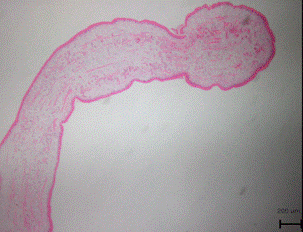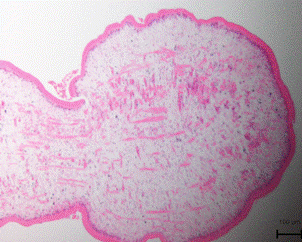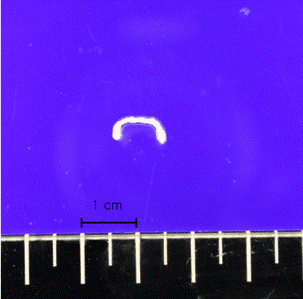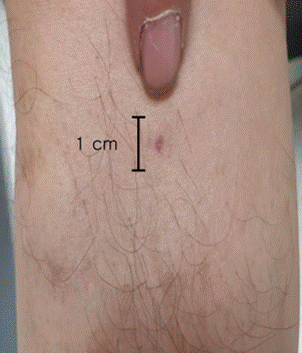Category: Myoclonus
Objective: While various neurological symptoms of sparganosis including have been reported, this is the first documented instance in which sparganosis presented with myoclonus.
Background: Sparganosis is a rare infection caused by parasitic tapeworms of the genus Spirometra, known to be transmitted through ingesting freshwater or raw meat, or via direct contact through an open wound. While sparganosis features a wide variety of clinical presentations including dermatological, muscular, ocular and neurological abnormalities, this is the first documented instance in which sparganosis presented with myoclonus.
Method:
A. Physical examination
B. X-rays of the lower legs
C. CT Brain
D. 3T head MRI
E. Electroencephalogram (EEG) , Nerve conduction study (NCS) and Motor evoked potential (MEP) with somatosensory evoked potential (SSEP)
Results: A. There was a well-circumscribed, oval-shaped erythematous papule on the right leg, approximately 7.5 cm inferior to the right patella. Size was approximately 3mm in diameter. There was a rubbery consistency and absence of tenderness upon palpation.
B. X-rays of the lower legs were unremarkable.
C. CT Brain showed presence of right maxillary sinusitis.
D. 3T head MRI revealed minimal small vessel ischemic lesions in the white matter of both hemispheres, and ruled out an aneurysm (3mm) in the region surrounding the left posterior communicating artery.
E.EEG showed repetitive 5Hz sharp waves. There were no pathological rhythms or epileptic discharges. Nerve conduction study was normal. Motor evoked potential and somatosensory evoked potential of both legs were unremarkable.
Conclusion: This was the case of a 65-year-old Korean male who presented to the ER with pruritus and involuntary movement in his right leg. Physical examination revealed a well-circumscribed red papule on his right leg with a diameter of approximately 3mm and rubbery consistency. The lesion was initially suspected to be a lymphoma, lipoma or cyst but a Sparganum larva was detected in his punch biopsy specimen, and the patient was ultimately diagnosed with Sparganosis.
References: Ahn SK, Choi HJ, Kim JH. Subcutaneous Sparganosis on Abdomen Mimicking Multiple Lipomas. Korean J Parasitol. 2019 Oct;57(5):513-516. doi: 10.3347/kjp.2019.57.5.513. Epub 2019 Oct 31. PMID: 31715692; PMCID: PMC6851251.
Chang JH, Lin OS, Yeh KT. Subcutaneous sparganosis–a case report and a review of human sparganosis in Taiwan. Kaohsiung J Med Sci. 1999 Sep;15(9):567-71. PMID: 10561983.
Cui J, Wang Y, Zhang X, Lin XM, Zhang HW, Wang ZQ, Chen JX. A neglected risk for sparganosis: eating live tadpoles in central China. Infect Dis Poverty. 2017 May 4;6(1):58. doi: 10.1186/s40249-017-0265-7. PMID: 28468685; PMCID: PMC5415782.
Hong D, Xie H, Wan H, An N, Xu C, Zhang J. Efficacy comparison between long-term high-dose praziquantel and surgical therapy for cerebral sparganosis: A multicenter retrospective cohort study. PLoS Negl Trop Dis. 2018 Oct 22;12(10):e0006918. doi: 10.1371/journal.pntd.0006918. PMID: 30346956; PMCID: PMC6211769.
Kudesia S, Indira DB, Sarala D, Vani S, Yasha TC, Jayakumar PN, Shankar SK. Sparganosis of brain and spinal cord: unusual tapeworm infestation (report of two cases). Clin Neurol Neurosurg. 1998 Jun;100(2):148-52. doi: 10.1016/s0303-8467(98)00027-4. PMID: 9746305.
Kwon JH, Kim JS. Sparganosis presenting as a conus medullaris lesion: case report and literature review of the spinal sparganosis. Arch Neurol. 2004 Jul;61(7):1126-8. doi: 10.1001/archneur.61.7.1126. PMID: 15262748.
Liu Q, Li MW, Wang ZD, Zhao GH, Zhu XQ. Human sparganosis, a neglected food borne zoonosis. Lancet Infect Dis. 2015 Oct;15(10):1226-1235. doi: 10.1016/S1473-3099(15)00133-4. Epub 2015 Sep 9. PMID: 26364132.
Magill AJ, Ryan ET, Hill DR, Solomon T. Hunter’s Tropical Medicine and Emerging Infectious Diseases. 9th ed. China: Elsevier Inc; 2013.
Mueller JF. Potential longevity of life history stages of Spirometra spp. J Parasitol. 1974 Apr;60(2):376-7. PMID: 4821129.
Nathavitharana RR, Fleischmann-Rose K, Yassa DS, Wertheimer MD, Alonso CD. An Unusual Cause of a Breast Mass in a Patient from China. Am J Trop Med Hyg. 2015 Aug;93(2):347-9. doi: 10.4269/ajtmh.15-0235. Epub 2015 Jun 1. PMID: 26033021; PMCID: PMC4530759.Omidian, Z., and R. Gilman. 2013. Sparganosis. Handbook of clinical neurology 135: 960–963.
Pampiglione S, Fioravanti ML, Rivasi F. Human sparganosis in Italy. Case report and review of the European cases. APMIS. 2003 Feb;111(2):349-54. doi: 10.1034/j.1600-0463.2003.1110208.x. PMID: 12716392.
Sarma DP, Weilbaecher TG. Human sparganosis. J Am Acad Dermatol. 1986 Nov;15(5 Pt 2):1145-8. doi: 10.1016/s0190-9622(86)70284-3. PMID: 2945847.
Tsou MH, Huang TW. Pathology of subcutaneous sparganosis: report of two cases. J Formos Med Assoc. 1993 Jul;92(7):649-53. PMID: 7904502.
Walker MD, Zunt JR. Neuroparasitic infections: cestodes, trematodes, and protozoans. Semin Neurol. 2005 Sep;25(3):262-77. doi: 10.1055/s-2005-917663. PMID: 16170739; PMCID: PMC2683840.
Yoon KC, Seo MS, Park SW, Park YG. Eyelid sparganosis. Am J Ophthalmol. 2004 Nov;138(5):873-5. doi: 10.1016/j.ajo.2004.05.055. PMID: 15531332.
To cite this abstract in AMA style:
EJ. Choi, DG. Lee, AR. Lim. A Man Who Has Been Presenting with Pruritus and Myoclonus [abstract]. Mov Disord. 2022; 37 (suppl 2). https://www.mdsabstracts.org/abstract/a-man-who-has-been-presenting-with-pruritus-and-myoclonus/. Accessed April 20, 2025.« Back to 2022 International Congress
MDS Abstracts - https://www.mdsabstracts.org/abstract/a-man-who-has-been-presenting-with-pruritus-and-myoclonus/




